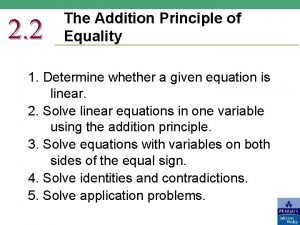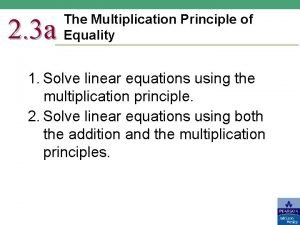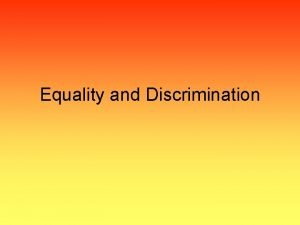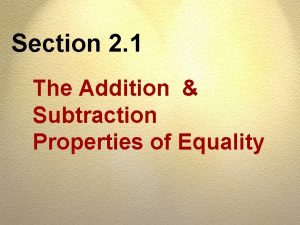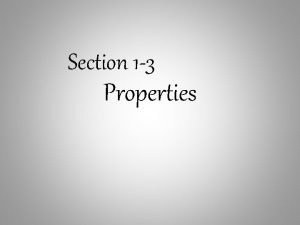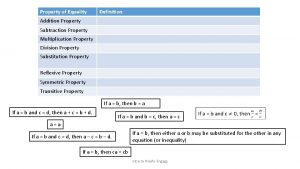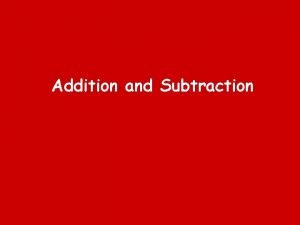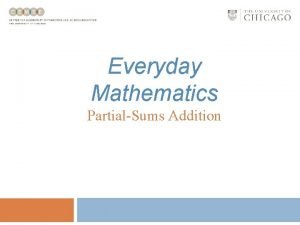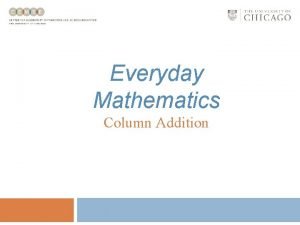Section 2 1 The Addition Principle of Equality








- Slides: 8

Section 2. 1 The Addition Principle of Equality Copyright © 2012, 2009, 2005, 2002 Pearson Education, Inc.

Equations An equation uses an equal sign (=) and indicates that two expressions are equal. 6 + 7 = 13 An equation always has an equal sign. 6+7=x The solution of an equation is the number which makes the equation true. 6 + 7 = 13 13 is the solution for this equation since it makes 6 + 7 = x true. Copyright © 2012, 2009, 2005, 2002 Pearson Education, Inc. 2

Equivalent Equations that have exactly the same solution are called equivalent equations. 6 + x = 13 x=7 7 is the solution to the equation 6 + x = 13. The process of finding all solutions of an equation is called solving the equation. Copyright © 2012, 2009, 2005, 2002 Pearson Education, Inc. 3

The Addition Principle The Addition Principal If the same number is added to both sides of an equation, the results on both sides are equal in value. We need to find the value of x. 6 + x = 13 6 + x + ( 6) = 13 + ( 6) Adding ( 6) to both sides of the equation will maintain the balance of the equation. x=7 Left side Right side Solution to the equation. Copyright © 2012, 2009, 2005, 2002 Pearson Education, Inc. 4

Example Solve a 6. 2 = 3. 5. 6. 2 is the opposite of 6. 2. Add 6. 2 to both sides of the equation. a 6. 2 = 3. 5 a 6. 2 + (6. 2) = 3. 5 + (6. 2) a = 2. 7 Check your answer in the original equation. (2. 7) 6. 2 = 3. 5 Copyright © 2012, 2009, 2005, 2002 Pearson Education, Inc. 5

Example Solve for c. 3 c 8 = 2 c 15 3 c 8 + 8 = 2 c 15 + 8 3 c = 2 c 7 3 c + ( 2 c) = 2 c 7 + ( 2 c) c = 7 3( 7) 8 = 2( 7) 15 21 8 = 14 15 Add 8 to both sides of the equation. Add 2 c to both sides of the equation. Check your answer in the original equation. 29 = 29 Copyright © 2012, 2009, 2005, 2002 Pearson Education, Inc. 6

Example Is 5 the solution of the equation – 10 + 4 = x – 2? Substitute 5 for x and see if we obtain an identity. – 10 + 4 = x – 2 – 10 + 4 = 5 – 2 – 6 ≠ 3 Thus, 5 is not the solution. Solve for the solution. – 10 + 4 = x – 2 – 6 = x – 2 – 4 = x Check: Replacing x with – 4 in the original equation, verifies the solution. Copyright © 2012, 2009, 2005, 2002 Pearson Education, Inc. 7

Example Find the value of y that satisfies the equation The LCD is 10. Simplify. Be sure to check your answer in the original equation. Simplify. Add to both sides of the equation and simplify. Copyright © 2012, 2009, 2005, 2002 Pearson Education, Inc. 8
